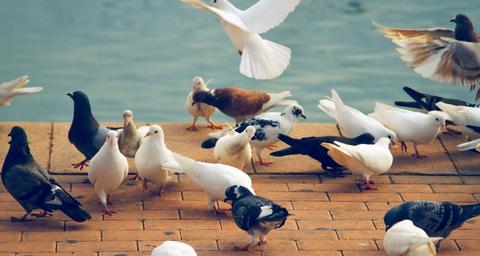Pigeons frequently spotted in our gardens or city centers
The Columbidae family encompasses both doves and pigeons, boasting approximately 1,100 distinct pigeon breeds, encompassing various breeds and hybrids. Among these, the following pigeon types are the ones we most commonly encounter:
1. The feral pigeon, often referred to as the city pigeon, is a ubiquitous presence in urban environments worldwide. Descended from domestic pigeons, they were initially released and have since adapted to the urban landscape due to the abundance of food and shelter.
These pigeons are characterized by their slender build and distinctive cyan-purple neck without a white spot. They have earned the colloquial moniker 'the rats of the sky.' Typically standing at a height of 30-35 cm and weighing between 270-550 grams, they have become a familiar sight in our urban jungles.
2. Domestic pigeons, like racing or homing pigeons, are raised for various purposes, including long-distance races and historical communication roles. These pigeons exhibit exceptional flight capabilities and possess remarkable navigational skills. A distinctive feature that sets them apart is the presence of a leg ring, used for identification.
3. White doves are frequently chosen for special occasions like weddings, where they are released and gracefully return to their home loft. These doves are characterized by their pristine white plumage, slender physique, elegant pink beaks, and striking, shiny black eyes.
4. Wood pigeons are wild pigeons that are fatter, heavier built and bigger than other European pigeons. They prefer to nest in quiet, green environments and you can find them waddling around your garden or in parks. They can be distinguished by their pinkish gray chest, red-orange beak and white neck.
Pigeon Cultivation and Breeding
In urban settings, pigeons commonly build nests in and around buildings, favoring spots like ledges, eaves, or support beams. These nests are usually crafted from a mix of grass, twigs, and sometimes even discarded materials such as plastic or textiles. On the flip side, wood pigeons prefer making their nests in dense foliage or large trees.
The breeding season typically spans from March to July, although many pigeons have the ability to breed throughout the entire year. A typical clutch consists of two off-white eggs, usually laid consecutively within days.
The incubation period lasts approximately 18 days, and the hatchlings start developing feathers in about 30 days. Interestingly, city pigeons can start another nesting cycle when the first batch of fledglings is as young as 20 days old. This means that a pair has the potential to produce up to nine nests in a single year.
What Do Pigeons Eat?
Pigeons really like to munch on seeds, grains, fruits, and crops, but they'll gobble up lots of different things. On an average week, they chow downabout 450 grams of food.
What factors contribute to the frequent sightings of pigeons in large numbers?
Pigeons have a natural inclination to gather in sizable flocks, and this behavior offers several advantages. It provides them with safety in numbers, increases their odds of finding food, and serves as a defense against potential predators.
Over time, pigeons have adapted their distinctive cooing to ensure it carries through the bustling urban landscape.
As a result, their cooing can be heard from quite a distance, which, while fascinating, can occasionally become a bit bothersome.
Are all birds we find in urban areas considered pests?
WHICH BIRDS ARE PROTECTED AND WHICH ARE NOT
Urban environments host a diverse range of wildlife, and it's essential to foster and protect this biodiversity. Yet, the abundance of discarded food in cities can lead to rapid population growth among certain species like pigeons.
This surging population often results in various social and environmental issues, including increased noise, pollution, building decay, disease transmission, and more. Consequently, it becomes crucial to implement bird control measures sanctioned by local authorities to strike a balance between urban coexistence and preservation.
DIY Tips to Keep Pigeons and Other Birds Away
Pigeons are resilient and flexible birds, and using a mix of methods is often better than relying on just one. Here are some helpful tips:
- Seal off any openings or gaps where pigeons could find shelter.
- Make sure all garbage bins are tightly sealed to discourage pigeons.
- Eliminate bird feeders to reduce attractions for pigeons.
- Hang reflective items like aluminum foil strips, CDs, or reflective tape near areas pigeons frequent.
Learn more DIY tips to get rid of birds naturally
